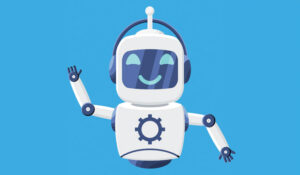Kerstin Geßner at injixo looks at AI in the contact centre and asks if it can spark joy for your employees.
Alright, let’s face it: this is probably the umpteenth article on artificial intelligence (AI) that you’ve come across this week alone. No doubt the topic is everywhere, including in the contact centre industry.
Discussions about AI’s potential to streamline operations, reduce wait times, and cut costs are becoming increasingly common. Companies everywhere are tuning in, with many already utilizing AI technologies, and others actively preparing to introduce them.
However, alongside the excitement, there’s a growing sense of apprehension, particularly in customer service. Headlines such as “Call centre agents replaced by AI” or “Will our future conversations be only with robots?” reflect a rising concern about what’s to come.
Embracing AI: Fear and Opportunity
Undoubtedly, a certain percentage of your employees may be wrestling with the fear of redundancy, the daunting prospect of AI rendering their roles obsolete.
It’s true, only a handful may instantly grasp the raft of benefits and prospects that this technology brings. But the AI conversation is here to stay, and avoidance isn’t an option.
Downplaying the imminent AI implementation or its potential to overhaul workflow isn’t a winning strategy. Instead, steering the narrative positively and proactively, accepting and molding this inevitable shift is the way forward.
Let’s take a look at the wealth of advantages that AI presents for all stakeholders. We aim to shed light on how your contact centre can incorporate AI, creating a win-win scenario for everyone involved – you, your customers, and your employees.
Where Is AI Applied in Contact Centres?
Most contact centres use Conversational IVR (Interactive Voice Response), which are voice-controlled systems capable of deciphering speech and providing appropriate responses. This sets them apart from conventional response systems.
Virtual assistants provide real-time support to agents, helping them respond more efficiently to customer inquiries.
AI-based analytics software not only collects conversation data but also identifies patterns and correlations, visualizing them. This allows for shortened work processes.
Forecasting becomes easier, faster, and much more accurate with the help of AI. Automatic calculation of future workload enables more precise and efficient planning.
The Benefits of AI for Your Contact Centre
24/7 Customer Support
AI never sleeps, making it available 24/7. This is a huge advantage because it ensures availability even when your employees are limited.
This not only takes the edge off scheduling challenges during off-peak hours, but also trims your budget for weekend and night shift allowances.
But the benefits aren’t just on your side of the fence. Your clients also get the assurance of round-the-clock accessibility.
Consider this: according to HubSpot’s 2022 State of Service Report, an “immediate” response to their queries is deemed important or very important by a whopping 90% of customers.
For 60% of them, “immediate” translates to a window of just 10 minutes or less. With AI, being ‘immediately’ available is no longer a daunting task, it’s the new normal.
Additionally, your customers can enjoy high-quality interactions. AI works with standardized answers and solutions.
A well-trained AI application typically doesn’t have “bad days” and makes fewer mistakes. Complex inquiries can be addressed more effectively and promptly by agents, as AI handles a portion of the contact volume or intelligently supports them in responding.
Reduction in Wait and Processing Times
Virtual assistants or chatbots pre-classify inquiries and answer them, in some cases automatically. If expertise is needed, customers are forwarded to the most suitable employees. This massively reduces waiting times.
AI tools can support your employees during customer conversations by providing them with real-time insights and recommendations based on customer needs. This lowers average handling time (AHT).
Improved Forecasting Accuracy
AI can help you create more precise forecasts. Intelligent algorithms analyze your historical data, automatically detecting trends, seasonality, and fluctuations in workload. Based on this, metrics such as AHT and contact volume can be calculated.
By incorporating individual opening hours and service levels, your forecasting becomes more accurate. This helps you schedule your employees with the right skills more efficiently and achieve your service level more easily.
Increased Efficiency
Self-service options help with customer satisfaction. They often prefer to solve their issues themselves, especially for simple inquiries that take less time. This leads to increased efficiency and productivity in your contact centre, as well as significantly reduced costs.
Benefits for Your Employees
Finally, let’s look at the numerous aspects of artificial intelligence that also benefit your employees.
Taking Over Simple, Repetitive Tasks
Answering the same questions or pre-sorting inquiries can make the workday monotonous. When AI handles, or at least pre-classifies, simple recurring customer inquiries, your employees can focus on more challenging tasks.
Faster and Easier Onboarding
Learning and practicing many small process steps can make the onboarding of new agents lengthy and tedious.
When you have AI in place, it knows the sequences and supports your employees in not missing a step and maintaining the correct order. Employees can concentrate on the content of customer inquiries rather than having to look up correct procedures in instructions.
Happier Customers
Shorter wait times and self-service options will make your customers happier. This also benefits your employees, as they will deal with fewer frustrated callers who have been in long queues or had to repeat their customer numbers and inquiries multiple times. As a result, conversation quality improves on both sides, making work more enjoyable.
Better Resource Utilization
Intelligent forecasts help avoid overstaffing and understaffing. This means less stress for your employees during understaffed periods and no boredom during overstaffed periods.
Opportunities for Development
When AI handles numerous first-level tasks, it opens up more opportunities for your employees to develop further. They can acquire additional skills or qualify as second-level agents.
Reduced Stress
The aforementioned points can lead to a significant reduction in stress levels among your employees. By reducing repetitive tasks, the risk of feeling bored is lessened.
Thanks to shorter conversation and wait times, employees can better adhere to their breaks and leave on time at the end of the day. Additionally, fewer escalations from customers further lower the emotional stress levels of your agents.
Positive Work Environment
When your employees are more satisfied, your employee turnover decreases. This will have a positive impact on the work environment.
Employees won’t feel like they’re in a revolving door position. Your reputation as an employer improves. And who wouldn’t want to work for a company with a good reputation?
Conclusion
Does AI truly make everyone involved in the contact centre happier? While no one can predict how AI will shape our future, AI technologies like ChatGPT, virtual chatbots, etc., will not replace humans in the workplace, but rather positively transform how tasks are performed. Instead, they’re here to augment how we work, making tasks less tedious and more manageable.
Therefore, AI should be seen not as a threat but as an opportunity. The collaboration between humans and artificial intelligence greatly enhances processes in contact centres, making work more interesting, effective, and overall more enjoyable for your employees.
Think streamlined processes, making work less of a grind and more engaging, which, in turn, can boost your employees’ morale and job satisfaction.
Embracing AI doesn’t mean bidding farewell to human involvement, especially for complex tasks that still require the human touch.
Instead, it opens the door to a new chapter of productivity and potential, transforming how we work and thrive in the contact centre landscape.
This blog post has been re-published by kind permission of Peopleware – View the Original Article
For more information about Peopleware - visit the Peopleware Website
Call Centre Helper is not responsible for the content of these guest blog posts. The opinions expressed in this article are those of the author, and do not necessarily reflect those of Call Centre Helper.
Author: Peopleware
Published On: 24th Jul 2023 - Last modified: 9th Dec 2024
Read more about - Guest Blogs, Peopleware






 Peopleware is a leading workforce management (WFM) solution, trusted by over 500,000 users in 30+ countries. With smart forecasting, automated scheduling and real-time management, organizations can optimize workforce efficiency and keep work aligned with demand. From precise time tracking to flexible planning, Peopleware helps organizations boost operational efficiency and foster a more engaged, productive workforce.
Peopleware is a leading workforce management (WFM) solution, trusted by over 500,000 users in 30+ countries. With smart forecasting, automated scheduling and real-time management, organizations can optimize workforce efficiency and keep work aligned with demand. From precise time tracking to flexible planning, Peopleware helps organizations boost operational efficiency and foster a more engaged, productive workforce. 









